 Russia’s parliament recently voted 380 to 3 favoring decriminalization of domestic violence against women where it doesn’t cause “substantial bodily harm” and occurs “not more than once per year”. So… in Russia—once again—it’s socially acceptable to beat the wife. Makes you wonder how the United States Violence Against Women Act will stand given the Trump administration’s apparent admiration for how Vladimir Putin does business, never mind Donald Trump’s personal treatment of women.
Russia’s parliament recently voted 380 to 3 favoring decriminalization of domestic violence against women where it doesn’t cause “substantial bodily harm” and occurs “not more than once per year”. So… in Russia—once again—it’s socially acceptable to beat the wife. Makes you wonder how the United States Violence Against Women Act will stand given the Trump administration’s apparent admiration for how Vladimir Putin does business, never mind Donald Trump’s personal treatment of women.
Intimate Partner Violence is the politically correct term for wife-beating. It’s a serious and common criminal offense. For years physical, emotional, sexual and financial abuse of female spouses was conveniently overlooked because what went on in private homes was supposed to be no one else’s business. That’s until women fought back and killed their spouses. Then they were prosecuted for murder with all the zeal reserved for serial killers.
 Many battered women were convicted of murder and given lengthy jail sentences. There was no regard for the big picture of what created intimate partner violence, how it led to homicidal acts, and what effect it had on entire families—especially children—as well as society in general.
Many battered women were convicted of murder and given lengthy jail sentences. There was no regard for the big picture of what created intimate partner violence, how it led to homicidal acts, and what effect it had on entire families—especially children—as well as society in general.
But some women were acquitted of criminal culpability for killing their partners.
They invoked self-defense because they suffered years of cyclic abuse and finally fought back in order to prevent themselves and their children from the imminent threat of grievous bodily harm or being murder victims themselves. These women weren’t claiming temporary insanity or a moment of heated passion. They were telling the truth about years of mental torture that drove them to commit the ultimate act of violent response because they were suffering from the Battered Woman Syndrome.
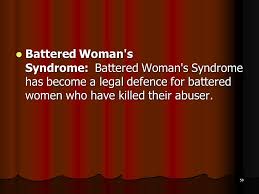 Battered Woman Syndrome is not a recognized medical or mental disorder according to the psychiatric profession’s Diagnostic and Statistical Manual. Battered Woman Syndrome is a contributing factor to Post Traumatic Stress Disorder but they are two separate issues. On its own, Battered Woman Syndrome is not a specifically accepted defense in most courts. Battered Woman Syndrome is part of an overall defense to criminal accusations. It’s a clinical explanation for using violence to proactively defend one’s self and it’s supported by expert testimony that encompasses the entire case facts. That includes the history of the intimate partner relationship, the mechanism of the killing, and the aftermath that followed.
Battered Woman Syndrome is not a recognized medical or mental disorder according to the psychiatric profession’s Diagnostic and Statistical Manual. Battered Woman Syndrome is a contributing factor to Post Traumatic Stress Disorder but they are two separate issues. On its own, Battered Woman Syndrome is not a specifically accepted defense in most courts. Battered Woman Syndrome is part of an overall defense to criminal accusations. It’s a clinical explanation for using violence to proactively defend one’s self and it’s supported by expert testimony that encompasses the entire case facts. That includes the history of the intimate partner relationship, the mechanism of the killing, and the aftermath that followed.
The battered woman defense component is widely used to establish diminished responsibility of a woman accused of killing her husband under circumstances where he was incapacitated and not able to defend himself nor be an immediate physical threat. The battered woman defense is highly successful in many cases.
 The highest-profile battered woman case was portrayed in The Burning Bed, a true-crime movie from 1984 where Farrah Fawcett played Francine Hughes, a severely battered woman who killed her husband in Dansville, Michigan, by setting him on fire while he slept. Francine was charged with first-degree murder and acquitted by a jury who found her not guilty by her having to use a temporary insanity defense.
The highest-profile battered woman case was portrayed in The Burning Bed, a true-crime movie from 1984 where Farrah Fawcett played Francine Hughes, a severely battered woman who killed her husband in Dansville, Michigan, by setting him on fire while he slept. Francine was charged with first-degree murder and acquitted by a jury who found her not guilty by her having to use a temporary insanity defense.
Thirty-three years ago, the Battered Woman Syndrome was starting to be explored by the courts. There was little psychiatric or psychological science available to establish the reliability of this murder defense tactic. Today, much more is known about the patterns causing intimate partner violence and how they inescapably lead to defensive killings, even when the deceased spouse was incapacitated and not an apparent immediate danger.
Thirty-one years ago, I was lead investigator where a battered woman shot and killed her abusive husband while he slept. Deeana Bingingham suffered years of domestic cruelty at the hands, feet, words, wallet and penis of Lyle (Bing) Bingingham—much of it watched and heard by their 10-year-old son, Logan, and 8-year-old daughter, Kiley.
 Bing was on the run from ripping a criminal organization and moved the family to an isolated cabin in the Pacific Northwest. He came home one snowy, stormy night—drunk—as usual—and attacked Deeana. He beat her with his fists and boots, sexually assaulted Deeana in front of their children, then threatened to shoot the family with a 30/30 Winchester. Bing passed out. Deeana took the rifle. She shot Bing in the head.
Bing was on the run from ripping a criminal organization and moved the family to an isolated cabin in the Pacific Northwest. He came home one snowy, stormy night—drunk—as usual—and attacked Deeana. He beat her with his fists and boots, sexually assaulted Deeana in front of their children, then threatened to shoot the family with a 30/30 Winchester. Bing passed out. Deeana took the rifle. She shot Bing in the head.
The first bullet didn’t kill Bing. It tore off his jaw and ripped out an eye. Bing rose in a rage—thrashing—ki-yiiing—gurgling—spewing blood everywhere. He clawed to get up… folded… stood… lunged… then fell and crawled to get at her. Vibrating, gasping and backing away, Deeana levered the gun to reload. It jammed. She threw it. Ran to the closet. And grabbed a 30.06 bolt-action. Deeana scrambled for cartridges, pleading to little Logan for help while Kiley cringed in a corner. The boy loaded the second rifle. The tiny girl watched. As a family… they finished Bing off.
 Deeana Bingingham’s children were apprehended. She was jailed on second-degree (non-capital) murder charges—the prosecutor deeming killing Bing was intentionally committed but not premeditated. Deeana spent 2 years on remand while her kids bounced between foster homes and her family abandoned her. She invoked battered woman syndrome in defense and her story was a nightmare to hear. Deeana was offered a plea bargain to manslaughter or an accepted defense of temporary insanity with a compromised offer of family counseling for rehabilitation rather than risking a convict’s chance at parole. Deeana refused. She chose to stay in jail, waiting her chance to tell the court—and other battered women—her plight.
Deeana Bingingham’s children were apprehended. She was jailed on second-degree (non-capital) murder charges—the prosecutor deeming killing Bing was intentionally committed but not premeditated. Deeana spent 2 years on remand while her kids bounced between foster homes and her family abandoned her. She invoked battered woman syndrome in defense and her story was a nightmare to hear. Deeana was offered a plea bargain to manslaughter or an accepted defense of temporary insanity with a compromised offer of family counseling for rehabilitation rather than risking a convict’s chance at parole. Deeana refused. She chose to stay in jail, waiting her chance to tell the court—and other battered women—her plight.
The jury heard a shocking story. A sickening story. A story of horrific psychological, financial, sexual abuse and extreme, prolonged physical violence. The jury acquitted Deeana. They reasoned Deeana was a provoked, trapped and helpless victim of ritualistic domestic violence. They found proactively killing her intimate partner was Deeana’s only reasonable recourse—Deeana ultimately protected herself and her children.
Deeana Bingingham’s case never left my mind. I got a tremendous education into what causes an intimate partner killing that has a legitimate spousal homicide defense. Today, a lot more is known about battered women behavior and the psychological syndrome surrounding their necessary violent acts of defense.
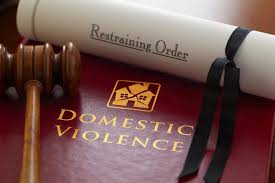 The primary legal principle applied to Battered Woman Syndrome homicide defense is the accused woman being constantly subjected to severe domestic abuse making her unable to take independent action in conventionally leaving the relationship and a firm belief the escalating pattern of violence would end with her death and/or that of her children. Eventually, the situation explodes and the battered woman—hopelessly affected by a clearly-defined, state-of-mind syndrome—takes an immediate opportunity to protect herself by proactively killing her husband through whatever available means.
The primary legal principle applied to Battered Woman Syndrome homicide defense is the accused woman being constantly subjected to severe domestic abuse making her unable to take independent action in conventionally leaving the relationship and a firm belief the escalating pattern of violence would end with her death and/or that of her children. Eventually, the situation explodes and the battered woman—hopelessly affected by a clearly-defined, state-of-mind syndrome—takes an immediate opportunity to protect herself by proactively killing her husband through whatever available means.
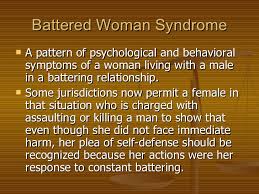 On its own, Battered Woman Syndrome is part of a self-defense argument and used to explain a battered woman’s experiences that caused her to commit proactive homicide. A crucial part of having Battered Woman Syndrome admitted as trial defense evidence is the case facts being examined by a professional who specializes in the psychiatric and psychological elements of the syndrome and introduces their opinion of the accused’s mental state through expert testimony.
On its own, Battered Woman Syndrome is part of a self-defense argument and used to explain a battered woman’s experiences that caused her to commit proactive homicide. A crucial part of having Battered Woman Syndrome admitted as trial defense evidence is the case facts being examined by a professional who specializes in the psychiatric and psychological elements of the syndrome and introduces their opinion of the accused’s mental state through expert testimony.
The American legal precedent in having Battered Woman Syndrome admitted as a contributing factor to homicide defense is called the Dyas Standard from the case Dyas v. the United States. It’s simple, yet complicated. First, the defense team must establish the accused is a battered woman within the accepted behavior parameters of the syndrome. Second, they must persuade a court the jury would be aided by expert testimony that Battered Woman Syndrome is relevant to explaining her behavior.
Once Battered Woman Syndrome because of Intimate Partner Violence is determined relevant, it has two more legal hurdles to jump. Expert testimony must be admissible, then it has to show a probative value that outweighs prejudicial impact. Making matters more complicated, Dyas Standard admissibility has a three-pronged test.
- The testimony’s subject matter “must be so distinctly related to some science, profession, business or occupation as to be beyond the ken of the average layman (layperson).”
- The witness “must have sufficient skill, knowledge or experience in that field or calling as to make it appear that his (her) opinion or inference will probably aid the trier in his (her) search for truth”.
- Expert testimony is inadmissible if “the state of the pertinent art or scientific knowledge does not permit a reasonable opinion to be asserted even by an expert”.
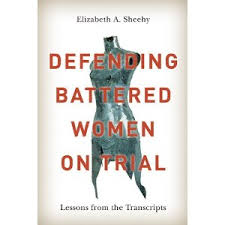 This might sound like a bunch of masculine, legal mumbo-jumbo but it says a recognized and reliable expert opinion about how a history of spousal abuse led to the accused’s perception—at the time of the act they had no other recourse than to ultimately defend themselves by killing their intimate partner—is valid evidence that may help a jury deciding if the accused was criminally culpable. Perception in the accused’s mind—at the time of the act—is central to a self-defense claim and Battered Woman Syndrome testimony is meant to educate the jury about the realities of intimate partner violence.
This might sound like a bunch of masculine, legal mumbo-jumbo but it says a recognized and reliable expert opinion about how a history of spousal abuse led to the accused’s perception—at the time of the act they had no other recourse than to ultimately defend themselves by killing their intimate partner—is valid evidence that may help a jury deciding if the accused was criminally culpable. Perception in the accused’s mind—at the time of the act—is central to a self-defense claim and Battered Woman Syndrome testimony is meant to educate the jury about the realities of intimate partner violence.
Presenting a spousal abuse history proving Battered Woman Syndrome is difficult. This defense requires detailed investigation into years of abuse that’s often not documented or credibly supported by independent observations or interventions by other family members, friends, acquaintances and support professionals like social workers, medical responders, police officers, and court records.
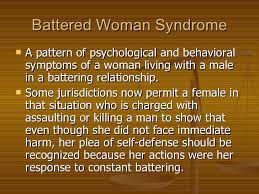 Sadly, the reality of intimate partner violence or spousal abuse is specific incidents are seldom recorded or reported. Battered Woman Syndrome is based on a cumulative pattern of countless small and large incidents of verbal, mental, financial, mental, physical and sexual assaults that build up to a point of explosion, ending in death. So many cases have mitigating circumstances where the woman victim didn’t report most incidents, many peripheral witnesses have convenient lapses of memory, and responsible professionals fail to intervene.
Sadly, the reality of intimate partner violence or spousal abuse is specific incidents are seldom recorded or reported. Battered Woman Syndrome is based on a cumulative pattern of countless small and large incidents of verbal, mental, financial, mental, physical and sexual assaults that build up to a point of explosion, ending in death. So many cases have mitigating circumstances where the woman victim didn’t report most incidents, many peripheral witnesses have convenient lapses of memory, and responsible professionals fail to intervene.
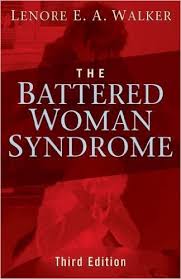 Battered Woman Syndrome is based on a known, cyclical pattern of abusive behavior and response first identified by Dr. Lenore Walker who is known as the mother of Battered Woman Syndrome. Dr. Walker conducted extensive research into intimate partner violence and established theories of victim’s psychological responses to spousal violence including a behavior called “learned helplessness” and a pattern of violence cycles.
Battered Woman Syndrome is based on a known, cyclical pattern of abusive behavior and response first identified by Dr. Lenore Walker who is known as the mother of Battered Woman Syndrome. Dr. Walker conducted extensive research into intimate partner violence and established theories of victim’s psychological responses to spousal violence including a behavior called “learned helplessness” and a pattern of violence cycles.
Learned helplessness is a state of mind where the woman has been long subjected to so much abuse that they feel totally incapable of defending themselves or voluntarily leaving the relationship. The emotional, financial, physical and entire realm of abuse causes the woman to lose any motivation to change their situation and they submit, rather than fight. Learned helplessness is a core element of Battered Woman Syndrome and it manifests in all cases.
Cycle theory encompasses the entire relationship period and has various degrees of severity and intervals. Cycle theory is another core element of Battered Woman Syndrome and it, too, manifest in all cases. There are three recognized violence cycles.
- Tension building is a phase where minor abuse incidents like emotional outbursts, verbal threats, and subtle punishments cause the woman to become hyper-vigilant to her partner’s cues and changes her behavior accordingly to diffuse them.
- Acute battering incidents are the second escalation. These are violent episodes where physical harm or severe emotional damage occurs.
- Reconciliation is the third cycle phase. It’s a loving contrition where the batterer claims to be remorseful, is charming, and promises never to harm the woman again. Invariably, the abuser blames his actions on outside influences like impairment substances, financial difficulty, or employment stress.
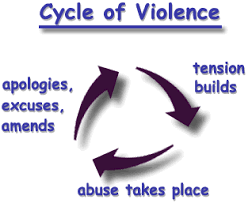 Battered Woman Syndrome becomes a vicious circle where the violence cycles repeat and become more frequent, making learned helplessness further entrenched. Over time, the tension-building and honeymoon stages get shorter and battering increases. This pattern results in battering incidents that become increasingly longer and more severe. The cycle works to wear women down and to keep them in a toxic relationship by controlling them, chipping away at their feeling of self-worth and independence.
Battered Woman Syndrome becomes a vicious circle where the violence cycles repeat and become more frequent, making learned helplessness further entrenched. Over time, the tension-building and honeymoon stages get shorter and battering increases. This pattern results in battering incidents that become increasingly longer and more severe. The cycle works to wear women down and to keep them in a toxic relationship by controlling them, chipping away at their feeling of self-worth and independence.
Abused partners hope their abusers will change. They falsely believe the batterer doesn’t mean to harm them, rather somehow they brought it on themselves. Secrecy, fear, lack of opportunity and low self-esteem combine to make leaving an abusive relationship extremely difficult—if not impossible.
 Ultimately, the heated cycle boils over and the helpless woman snaps. She takes a spontaneous and opportune, final defensive action without regard to repercussions. In her perception—at the time of the act—she has no recourse than to kill her partner. Otherwise, it’s inevitable she’ll die and so will her children. In law, this establishes a legitimate defense for homicide.
Ultimately, the heated cycle boils over and the helpless woman snaps. She takes a spontaneous and opportune, final defensive action without regard to repercussions. In her perception—at the time of the act—she has no recourse than to kill her partner. Otherwise, it’s inevitable she’ll die and so will her children. In law, this establishes a legitimate defense for homicide.
At the core of Battered Woman Syndrome lies a severe psychiatric impact that has four psychological stages.
DENIAL: The woman refuses to admit—even to herself—that she’s been beaten or that there’s a “problem” in her marriage. She may call each incident an “accident”. She offers excuses for her husband’s violence and each time firmly believes it’ll never happen again.
GUILT: She now acknowledges there’s a problem but considers herself responsible for it. She “deserves” to be beaten—she feels—because she has defects in her character and isn’t living up to her husband’s expectations.
ENLIGHTENMENT: The woman no longer assumes responsibility for her husband’s abusive treatment, recognizing that no one “deserves” to be beaten. She’s still committed to her relationship, though, and stays with her husband—hoping they can work things out.
RESPONSIBILITY: Accepting the fact that her husband will not—or cannot—stop his violent behavior, the battered woman decides she’ll no longer submit and takes self-defensive action. That can be leaving the relationship, seeking help and intervention, or taking termination matters into her own hands.
 The Battered Woman Syndrome is an ugly reality in many relationships. It may not occur in your intimacy but you can be sure it’s happening in a home near you. You probably know the symptoms of an abuser and recognize the behavior of a decent and loving partner. Here are the character traits of abusive and non-abusive men, irrespective of being physically violent.
The Battered Woman Syndrome is an ugly reality in many relationships. It may not occur in your intimacy but you can be sure it’s happening in a home near you. You probably know the symptoms of an abuser and recognize the behavior of a decent and loving partner. Here are the character traits of abusive and non-abusive men, irrespective of being physically violent.
An abusive man:
- Shouts
- Sulks
- Smashes things
- Glares
- Calls you names
- Makes you feel ugly and useless
- Cuts you off from your friends
- Stops you from working
- Never admits he’s wrong
- Blames you, drugs, alcohol, work, stress
- Turns the children against you
- Uses the children to control you
- Never does his share of the housework
- Never looks after the children
- Expects sex on demand
- Controls the money
- Threatens or coerces you to get his way
- Seduces those close to you
- Expects you to be responsible for his well-being
A non-abusive man:
- Is cheerful
- Is consistent
- Is supportive
- Tells you that you look good
- Tells you you’re competent
- Uses your right name or pet name
- Trusts you
- Trusts your judgment
- Respects you, your dignity, and your body
- Welcomes your family and your friends
- Encourages you to be independent
- Supports your higher learning and career
- Takes personal responsibility
- Admits to being wrong
- Is a responsible parent
- Is an equal parent
- Is a role model for the children
- Is faithful
- Shares money and assets
- Does his share of the housework




Thanks for raising this important issue, Garry. I’ve recently left my abusive partner after 32 years of marriage at the insistence of my children.
Unfortunately, many of those who are privy to abuse choose not to become involved. With the support of my children I am now re-discovering the person I was meant to be. Strong and true.
Hi Gina. Nice to hear from you and thanks so much for commenting. I’m terribly sorry to hear you suffered abuse for so long… that’s incredibly courageous of you to take the severance step just as it is to publically speak of it. Hold your head high. Be strong, true, and go onward and upward. My sincere best wishes for good things in your future! ~ Garry
This is an amazing, enlightening post, Gary. Thank you for sharing what so many people simply DO NOT understand. The common phrase, ‘Why doesn’t she just leave?’ is thrown about without any regard for the woman’s situation, and it’s extremely complicated, often involving financial abuse, children, and fear of death (not only of herself but her children).
Blaming women for men beating them or not leaving is a huge part of the issue.
Too many women die within 24 hours of leaving their abuser — this is hard fact. Sadly, the majority of abusers ARE men. What needs to change — how men treat women, how the laws are written to keep abusers away from their victims, anger mangement…I don’t have the answer. Your article, however, is a huge start. Thank you.
Thanks for commenting and sharing this post, Rachel. You’ve done so much to help battered women and sexual assault survivors – I truly respect your stance, efforts and the impact you have through your social reach and network. It’s only through intervention by education and helping victims that this massive problem can be lightened. Thank you for everything you do to make women’s lives safer.
For readers who don’t know Rachel Thompson and the work she’s done for abuse survivors, please visit her website at http://rachelintheoc.com/ and follow Rachel on Twitter – https://twitter.com/RachelintheOC
Fantastic post about a terrifying subject matter. Unfortunately, when the woman is going through it, she often feels there’s no way out. What a sad case you worked, Garry. It can’t be easy dealing with battered spouses, male or female. Men aren’t immune to the abuse either, as you know. Just ask Bob. LOL 🙂
Hey Sue – somehow I think you & Bob have a pretty mellow relationship but if I were him, I wouldn’t mess with you. After all, you do know 60 Ways to Murder someone 🙂 But in all seriousness, there are countless intimate relationships where violence is routine. Getting out of that mess is far harder than it appears.